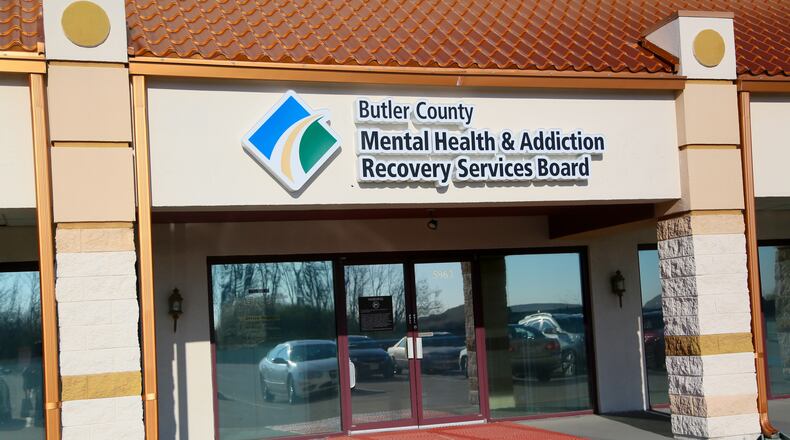The person would stay from 3 to 5 days and Medicaid would cover the bulk of treatment costs.
More recently the definition has been expanded to a place where police and family members can take people with mental illness who are having an episode.
Scott Rasmus, executive director of the Butler County Mental Health and Addiction Recovery Services Board, has studied five models so far, two in North Carolina, two in Ohio and one in Oregon. Based on those models he is estimating a Butler County facility could cost $6 million to $7 million to operate, which is up from the original price of $5 million to $6 million.
He and Commissioner Cindy Carpenter visited two facilities in North Carolina last week that are considered “best practices” models.
Carpenter said one of the best practices she learned on the visit is who utilizes the centers.
“I asked where do the referrals come from for the larger facility that’s serving Durham,” she said. “They come from homeless shelters, police drop-offs, hospitals, walk-ins, other facilities, group homes, their mobile crisis team and sometimes individuals just come in the door and have someone to talk to but don’t stay there. I think that’s the mix we’ll likely mirror.”
The commissioners have allocated $3 million of their American Rescue Plan Act dollars to the effort. Rasmus said they have applied to the state department for mental health and addiction for $750,000 to put toward capital costs for the project and his board would be required to match that amount if they get the grant.
He said until he gets an architect’s evaluation of the Care Facility he won’t know what the capital costs will be. Commissioner Don Dixon told the Journal-News he expects their ARPA money to largely pay to transform part of the nursing home.
“Ours is just in anticipation of the sticks and bricks and building changes and stuff like that mostly,” Dixon said. “Some for the start-up but most of it’s probably going to go to the renovation.”
As for ongoing costs at the two North Carolina centers, the one in Durham County — it serves about 250 people a month — costs $7 to $8 million a year to run and the other smaller one in the city of Henderson costs $3 million to $3.5 million annually.
The pair said the funding models in North Carolina are much different because they don’t have Medicaid expansion there, the police and hospitals also contribute financially to the centers.
“It’s interesting that their sheriff’s office and their hospitals provide some funding, because they believe they are diverting individuals from the jail and the hospital emergency rooms,” Carpenter said. “I don’t think it’s a large percentage of their budget but it is a contribution. I don’t know that that would save us any money, it’s sort of the same pot of money.”
Rasmus is finalizing a request for proposals that is expected to be released next month. At this point he favors adopting the North Carolina model.
Rasmus said both facilities have communal space with 23-hour observation chairs as well as longer term treatment rooms. After patients are stabilized in the observation area they are either referred out for wraparound services or admitted for two to five days for further in-house treatment.
“It treats clients in an open area to address their crisis needs but also to allow them to socialize with one another without any walls and that helps because of the socialization piece, they get maybe some support, some suggestions from each other on resources,” Rasmus said.
“It’s a combination of being able to observe everybody from a nurses station where you can look out on all these chair rather than look in the rooms. Then the socialization piece and the resource piece. So it works for the staffing and eyes on site and it works for the clients too.”
Carpenter said she wants to explore models that extend the stay beyond five days to offer “a continuum of care” but that could require touring more facilities. Rasmus said there are models that keep clients up to a month
Dixon said he was on a Zoom call with the Oregon facility where people are only there for an average of eight hours and then are sent out for wraparound services. He said “it’s going to have to be a design build here.”
“We’re going to have to open it on a small scale, test it, see what the results are and then see where the savings are...,” Dixon said he hasn’t discussed his idea with anyone yet but “my anticipation how it will start is small as a test prototype and see how it works and we’ll build off of that.”
As far as getting financial help from law enforcement agencies and hospitals like North Carolina does Dixon said that is an avenue to explore, not from the sheriff because his operation is funded by the county general fund but possibly other law enforcement agencies and hospitals.
“I think if it works the hospitals ought to have some interest, I do, as well as some others,” Dixon said. “Whoever uses it, kind of user pay as you go, but as different police entities use it and the life squads use it, we’ll have to figure out where the savings are and somebody is going to have to make some contributions back.”
Rasmus said they can get Medicaid reimbursement for about half the cost to run the facility, but there are efforts now being made to expand Medicaid covered services and episode rates and “if enhanced Medicaid gets endorsed in Ohio it could go up to like 80, 85, 90% covered by Medicaid.”
About the Author

